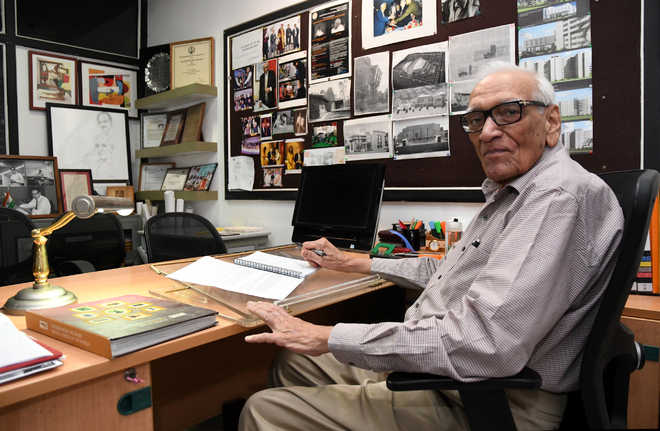
LOOKING BACK: SD Sharma
Amarjot Kaur
Much before he became a core team member of architects assisting Le Corbusier and Pierre Jeanneret in the making of Museum and Art Gallery of Chandigarh, Shiv Dutt Sharma struggled to earn a couple of 'annas' at refugee camps after the country's Partition.
The then 16-year-old Shiv had covered a long journey of pain and separation, first from Sialkot to Pasrur, and then from Dera Baba Nanak to Amritsar where he took up his first job-that of a labourer.
What he had known as home in Montgomery, where he lived with his parents and three brothers, was now in Pakistan. But that was not the only loss he suffered. At his office in Mansa Devi Complex, Panchkula, 86-year-old Sharma looks back at Partition days and recalls, "It was in July of 1947 when an announcement on the radio sent shivers down our spines and created panic that lasted for months, in fact, years to follow. For the ones who worked with the government, arrangements were made well in advance. The ones left to suffer were those who didn't have any strings to pull or those who chose to stay back thinking it would all be over soon."
Sharma was born in a middle-class household. His father taught in a private school. "DAV, actually," he remembers. "We were in Sialkot, visiting our relatives. On hearing the announcement, we all ran, without any money, or even clothes. My brother and I went with our mother, hiding in villages near Sialkot. The other two brothers accompanied my father. We had to split up to be safe," he reckons.
Nostalgia brings with it an expression of devastation that Sharma manages to balance while rearranging his spectacles, in a heavier baritone, he carries on. "We didn't even have utensils to have food on. After days, at a rivulet flowing through Sialkot, I saw my father and brothers standing on the other side. That was the beginning of our journey."
"I carried my father's elder brother, who was sick, on my back and walked five kilometres to reach Pasrur. With every step we took, the fear grew. We were to board a train to Dera Baba Nanak that very evening but it was impossible for a frail 16-year-old boy to tear through the mob. We decided to stay in the hall at the railway station."
Elaborating on the night at the station, Sharma shares, "There were around 40 to 50 people in that hall, too scared to go out and attend even nature's call; so the hall was also serving as a makeshift toilet. Each time we heard the beating of drums, we thought the blood-thirsty mobs were coming for us. The fear of getting killed kept us awake all night. The crack of dawn brought along a train that we boarded that morning. Thankfully, the Gorkha regiment was travelling in that train. They assured us of our safety till Dera Baba Nanak."
At the Dera, he says, they took refuge in a house abandoned by a Muslim family that moved to Pakistan. He says, "It was right next to the railway platform. Day in and day out, I saw trains loaded with bloodied corpses, some with their limbs chopped off, and brought many of them with my own hands to the dispensary where very few doctors attended to them. Meanwhile, my uncle's health continued to deteriorate and he succumbed to his illness. We didn't even have wood for his pyre, I tore batons from abandoned houses and performed his last rites at night. We did not even wait for his ashes to cool and picked his asthies as we left for Amritsar the same day."
A two-month stay at Dera Baba Nanak made way for Sharma and his family to enter Amritsar and then Jalandhar. "I picked up odd jobs, from being a labourer to a shopkeeper's helper, just to make enough money to study further. At one of the refugee camps, PUSA Institute Delhi was offering a two-year professional diploma, a stipend, and a hostel to live. I took it up. My cousin brother landed a job in Delhi with whom we stayed at Lodhi Colony-13 of us in a mumtee. All this while, I'd been wearing the same clothes I'd worn when we all left from Pakistan."
Sharma didn't land a job immediately. He was not 18 by the time the diploma got over. He had to start at the lowest rank. In 1963, he met Corbusier and in 1973 he left architect's office to take over as a chief architect in Department of Space at Bangalore to return again to Chandigarh. There, he served for ten years and rubbed shoulders with the likes of Abdul Kalam. "I wonder if life would be different had the partition not happened. For me, the adversity I braved back then only made me stronger," he signs off.
But in seven weeks it was done, the frontiers decided, A continent for better or worse divided — WH Auden on sir cyril radcliffe
As India celebrates 70 years of Independence, it’s time to look back at the haunting memory of Partition. The men and women affected by the agonising displacement may have come to terms with the trauma, yet memories can never be erased. Beginning today, we bring you a series on their bitter-sweet experiences



























